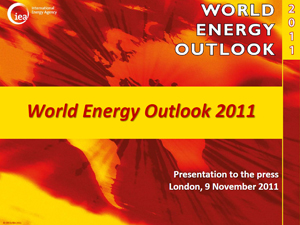Act now - or be locked in
on
Messages from the IEA's Energy World Energy Outlook 2011
Act now - or be locked in
EER's UK correspondent Alex Forbes attended the launch last week of the International Energy Agency's flagship publication, the World Energy Outlook, and reports on its major findings. The IEA has been sounding strong warnings to policymakers for some years now about the necessity to tackle climate change by switching to a low-carbon energy future. This year, for the first time, it has put a deadline to its warnings: by 2017, if present trends continue, the world will be locked into a 2°C temperature rise.
 |
| Maria van der Hoeven, Executive Director of the International Energy Agency: "The time to act is now" (photo: Reformatorisch Dagblad) |
Maria van der Hoeven, a former Minister of Economic Affairs in the Netherlands, took on the role of Executive Director of the International Energy Agency from the start of September. She has assumed leadership of the IEA at a critical time. In London last week she said: “My background is that of a policy-maker. And my mission at the IEA is to bridge the divide between analysts and politicians so that the right energy policy decisions are made by governments across the world.” Given what the IEA has to say in its eagerly awaited World Energy Outlook, its annual analysis of global energy trends, that sounds a Herculean task.
She continued: “Our analysis shows that the scale of the energy challenge is becoming increasingly difficult . . . Events such as the Fukushima nuclear accident and the turmoil in the Middle East and North Africa have thrown into question several aspects of our global energy future. At the same time ongoing concerns about the global economic recovery threaten to shift the focus of governments’ attention away from energy policy and limit their means of policy intervention . . . If there is one over-riding message that comes out of this year’s World Energy Outlook, it is that without an urgent and radical change of policy direction the world risks locking itself into an unsustainable energy future . . . There is still time to act, but the window of opportunity is closing fast . . . The time to act is now.”
This is not, of course, an entirely new message. We are used to hearing similar warnings from the IEA. What is different this year is that the IEA has put a date on when the door will slam shut if we do not act fast. By 2017 all the carbon emissions allowed in the agency’s 450 Scenario, the scenario that puts us on a trajectory that limits global warming to 2°C, will have been “locked in” by existing power plants, factories, buildings and so on. If we allow this to happen, the 2°C target will no longer be achievable and we will have to face the consequences of what climate scientists believe will be catastrophic climate change.
Projections - not forecasts
As in previous years, the IEA has presented three main scenarios, a set of internally consistent projections, “none of which should be considered as a forecast”. The scenarios run from 2010 to 2035.
The central case, the New Policies Scenario (NPS), incorporates the broad policy commitments and plans that have been announced by countries around the world “to tackle energy insecurity, climate change and local pollution, and other pressing energy-related challenges”. As many of these commitments relate only to the period to 2020, the IEA has assumed additional measures are
| There is still time to act, but the window of opportunity is closing fast |
In the NPS, primary energy demand increases by one-third between 2010 and 2035, with 90% of the growth in non-OECD economies. China consolidates its position as the world’s largest energy consumer, using nearly 70% more than the US by 2035, despite per capita consumption remaining below half the level in the US by then. The share of fossil fuels in the global primary energy mix falls only slightly, from around 81% today to 75% in 2035. The share of renewables rises from around 13% today to 18% by 2035, a figure that will disappoint people who see renewables as the main answer to our energy dilemmas. In this scenario, the increase in average global temperature above pre-industrial levels is 3.5°C.
China and India driving energy growth
Presenting the World Energy Outlook in London last week, the agency’s Chief Economist, Fatih Birol, said that in the NPS, China and India would together account for half of incremental energy demand from 2010 to 2035. “This means that decisions related to energy made in Beijing, New Delhi and Moscow will determine not only the energy sectors and economies in those countries but also others such as the OECD countries, through international trade linkages. So we are devoting more and more attention to those countries.”
One positive message is that in the NPS natural gas and renewables together meet two-thirds of incremental energy demand from 2010 to 2035, with the IEA reiterating what it said in June when it published a report entitled “Are we entering a golden age of gas?” Almost six months on, Birol believes that we probably are, so long as gas producers address the environmental challenges of unconventional gas production.
Demand for oil grows more slowly but, even so, in the NPS oil remains the world’s most important primary fuel, with demand rising from 87 million barrels/day now to 99 million b/d by 2035, largely because of a doubling of the world’s car fleet from 800 million vehicles today to 1.7 billion. Half of the growth is accounted for by China, mainly through rising car ownership.
Birol stressed that not only would more cars be driven in the developed world, more would also be manufactured in countries that do not have the high efficiency standards that have been put in place in
| There would be three unfortunate impacts of a lower nuclear future: it would be bad for the economics of energy production, bad for energy security and bad for climate change |
The Current Policies Scenario (CPS) models a future in which government policies do not change beyond those in place by mid-2011. These include, for example: China’s 12th Five-Year Plan for 2011-2015; new schemes in India for the trading of renewable energy certificates and support for alternative fuel vehicles; and EU directives covering energy efficiency in buildings and light commercial vehicles. Clearly, the CPS is not what will happen: governments will not suddenly cease enacting new policy. But the scenario sets a boundary condition, or benchmark, against which we can measure progress, or the lack of it. In this scenario global temperature increases by 6°C.
In the context of climate change, Birol said that coal, which he described as “the forgotten fuel”, accounted for half of all the energy growth over the past decade.
2°C looking ever more demanding
 |
| Click for slideshow of the WEO 2011's press presentation |
This year the scenario looks even more demanding than in 2010. Emissions climbed by a record 5.3% in 2010 after a dip in 2009. This higher starting point means that even bigger reductions will be needed in the future to meet the 2°C target. Moreover, the passing of another year means the difficulty and cost of meeting climate goals have increased as ongoing investments have locked in more high-carbon infrastructure.
In addition to these three scenarios, the IEA has modelled a number of “special cases”. A Deferred-Investment Case examines the impacts of countries in the Middle East and North Africa reducing investment in energy production as a consequence of the Arab Spring. A Low-Nuclear Case examines the consequences of nations heavily dependent on nuclear power having second thoughts and scaling it back or phasing it out, following the Fukushima nuclear crisis in Japan. Neither paints a reassuring picture.
Oil at $176/b by 2015?
In the NPS the price of oil (in 2010 dollars) approaches $120/b by 2035 and the world becomes increasingly reliant on a small number of producers. More than 90% of the required growth in oil output is in the nations of the Middle East and North Africa (Mena), requiring investment in the region of $100 billion each year. But what if the Mena nations fail to make these investments?
The IEA’s Deferred-Investment Case examines the consequences of investment falling short of required levels by one-third, because in the wake of the Arab Spring nations have new spending priorities, perceived risks are higher and some countries decide to develop their reserves more slowly than before. In this case Mena oil output is 3.4 million b/d lower than in the NPS by 2015 and 6.2 million b/d lower by 2020.
This, said Birol, would have “substantial impacts”. In real terms oil price would rise to $150/b by 2015, equivalent to $176/b in nominal terms, a “major risk to the health of the global economy”. Birol remains convinced that while high oil prices were not the prime cause of the great recession in 2008 and 2009, they were certainly a contributing factor.
The Fukushima effect
Another great uncertainty hanging over our energy future is what governments around the world may decide to do about nuclear power following the Fukushima nuclear crisis in Japan. The NPS assumes that nuclear power continues to grow strongly, on the basis that most of the countries with ambitious nuclear power programmes continue with their plans with little change. Such countries include China, India and South Korea.
But what if such governments were to have second thoughts and radically scale back or phase out nuclear power? The IEA’s Low-Nuclear Case examines the impacts of the nuclear component of global energy supply being cut by half. “The consequences,” says Birol, “are alarming. Renewables would fill
| If we don't change direction soon, we will end up where we're heading, which is towards an unsustainable energy future |
Asked what the World Energy Outlook has to say about the challenges of replacing baseload nuclear with intermittent renewables, Maria van der Hoeven said: “Every government has the right to decide its energy mix. But if you decide to phase out nuclear you have to ask some questions. And one of the questions is: how to bridge the gap. We have to be honest with people. If we want to phase out nuclear, what does it cost? How are you going to deal with renewables? How are we going to see system reliability? What are we going to do about energy security? It’s not just a matter of phasing out nuclear. It’s much more complicated than that.”
Against this backdrop of the myriad energy challenges that the world faces, Van der Hoeven takes up her new post with no illusions about the challenges involved: “There are few signs that the urgently needed shift in energy trends is under way. If we don’t change direction soon, we will end up where we’re heading, which is towards an unsustainable energy future. There is still some limited time to change course. But each year the necessary measures get progressively tougher and viciously more expensive. Can we afford to wait any longer? I don’t think so.”
To read Alex's interview with Fatih Birol on the World Energy Outlook, click here.


Discussion (0 comments)